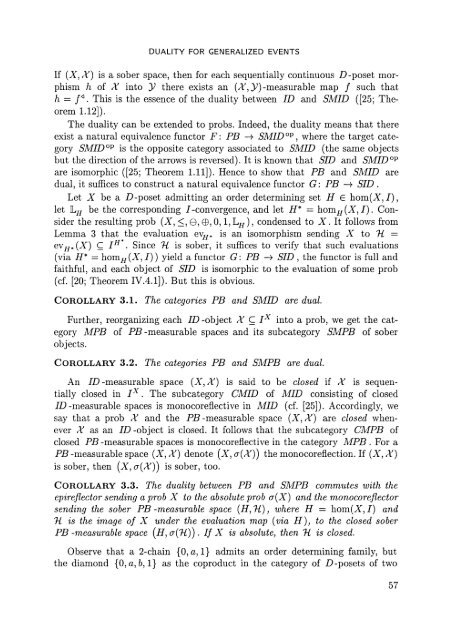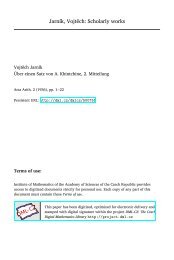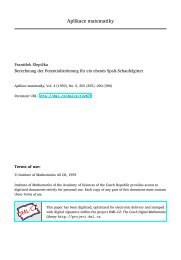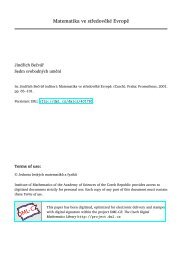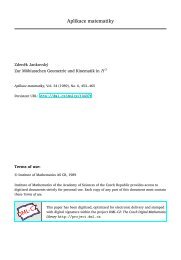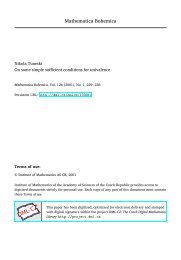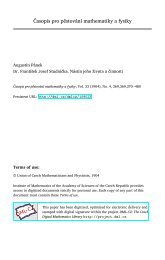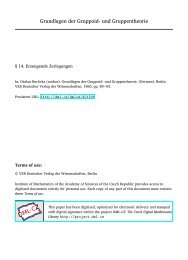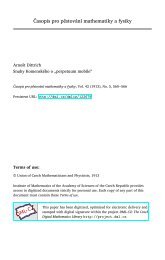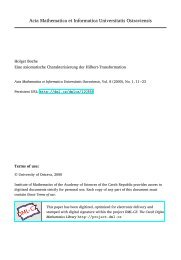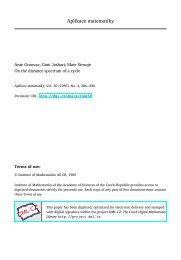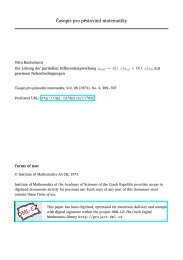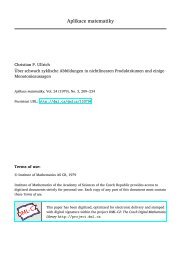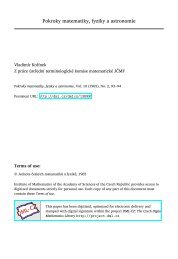Duality for generalized events
Duality for generalized events
Duality for generalized events
You also want an ePaper? Increase the reach of your titles
YUMPU automatically turns print PDFs into web optimized ePapers that Google loves.
DUALITY FOR GENERALIZED EVENTS<br />
If (X, X) is a sober space, then <strong>for</strong> each sequentially continuous D-poset morphism<br />
h of X into y there exists an (X, y) -measurable map / such that<br />
h = f«. This is the essence of the duality between ID and SMID ([25; Theorem<br />
1.12]).<br />
The duality can be extended to probs. Indeed, the duality means that there<br />
exist a natural equivalence functor F: PB -» SMID op , where the target category<br />
SMID op is the opposite category associated to SMID (the same objects<br />
but the direction of the arrows is reversed). It is known that SID and SMID op<br />
are isomorphic ([25; Theorem 1.11]). Hence to show that PB and SMID are<br />
dual, it suffices to construct a natural equivalence functor G: PB -» SID .<br />
Let X be a D-poset admitting an order determining set H £ hom(X, 7),<br />
let hH be the corresponding /-convergence, and let H* = hom//(X,I). Consider<br />
the resulting prob (X, SID , the functor is full and<br />
faithful, and each object of SID is isomorphic to the evaluation of some prob<br />
(cf. [20; Theorem IV.4.1]). But this is obvious.<br />
COROLLARY 3.1. The categories PB and SMID are dual.<br />
Further, reorganizing each ID -object X C I x into a prob, we get the category<br />
MPB of PB -measurable spaces and its subcategory SMPB of sober<br />
objects.<br />
COROLLARY 3.2. The categories PB and SMPB are dual.<br />
An ID-measurable space (X,X) is said to be closed if X is sequentially<br />
closed in I x . The subcategory CMID of MID consisting of closed<br />
ID-measurable spaces is monocoreflective in MID (cf. [25]). Accordingly, we<br />
say that a prob X and the PB -measurable space (X, X) are closed whenever<br />
X as an ID -object is closed. It follows that the subcategory CMPB of<br />
closed PB -measurable spaces is monocoreflective in the category MPB . For a<br />
PB -measurable space (X, X) denote (X, cr(X)) the monocoreflection. If (X, X)<br />
is sober, then (X, cr(X)) is sober, too.<br />
COROLLARY 3.3. The duality between PB and SMPB commutes with the<br />
epireflector sending a prob X to the absolute prob O~(X) and the monocoreflector<br />
sending the sober PB -measurable space (H, %), where H = hom(X, I) and<br />
T-L is the image of X under the evaluation map (via H), to the closed sober<br />
PB-measurable space (il, O-('H)). If X is absolute, then % is closed.<br />
Observe that a 2-chain {0, a, 1} admits an order determining family, but<br />
the diamond {0, a, b, 1} as the coproduct in the category of D-posets of two<br />
57


